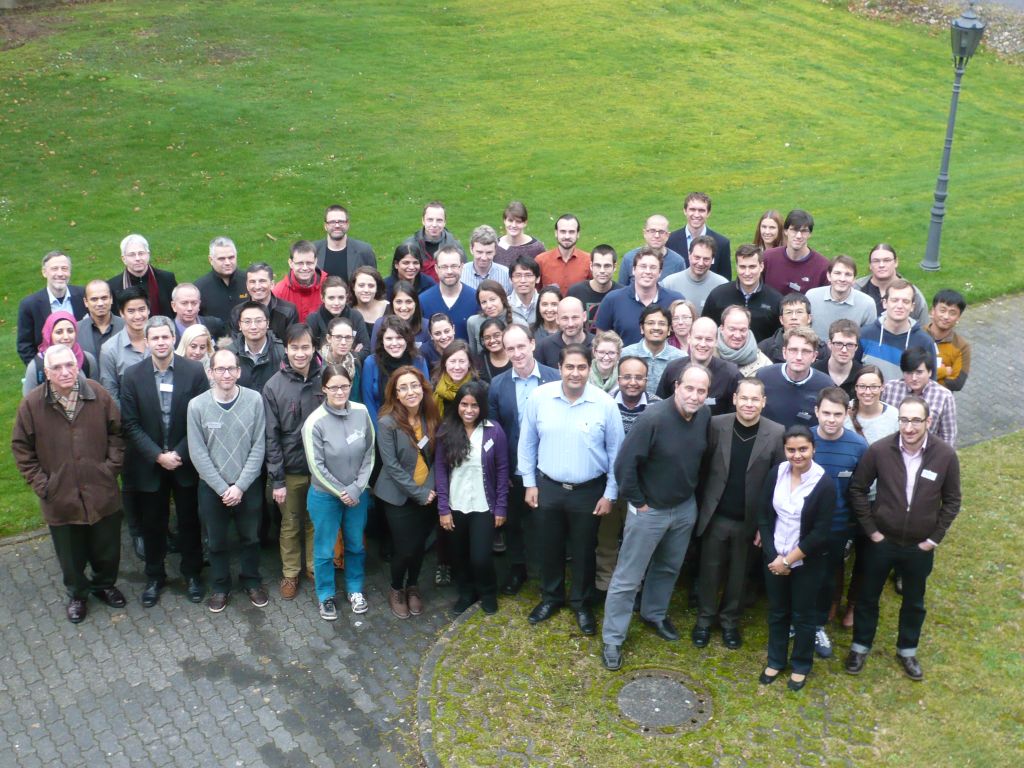552nd Wilhelm and Else Heraeus Seminar 2014
Physics of Biomolecular Folding and Assembly: Theory Meets Experiment
General Information
The WE-Heraeus-Seminar "Physics of Biomolecular Folding and Assembly: Theory meets Experiment" was held at the Physikzentrum Bad Honnef from Feb 2nd till Feb 6th (2014). It was generously funded by the WE-Heraeus-Stiftung.
Update 10 Feb 2014
We as organizers would like to thank all the participants for their contributions to the success of the seminar. We had great oral presentations by fantastic speakers from all around the world, many excellent posters, and a stimulating atmosphere for countless scientific discussions. Therefore, we would like to thank the WE-Heraeus-Stiftung for their generous financial and adminstrative support of this event which made all this possible.

On the molecular level life functions by concerted biomolecular machines, like proteins, RNA, or DNA. Both ingenious experimental advances and theoretical modeling have led to a significantly better understanding of the underlying principles. The 552nd WE Heraeus Seminar gathers experts from around the world to present and discuss the progress in this interdisciplinary field.
Scientific Organizers
Alexander Schug (schug∂kit.edu)
Abhinav Verma (abhinav.verma∂kit.edu)
Alphabetic List of Confirmed Speakers
- Orsolya Barabas, European Molecular Biology Laboratory, Heidelberg, Germany
- Robert Best, Laboratory of Chemical Physics, NIH, MD, USA
- Ralf Biehl, Forschungszentrum Jülich, Jülich, Germany
- Hendrik Dietz, Department of Physics, Technical University of Munich, Germany
- William A. Eaton, Laboratory of Chemical Physics, NIH, MD, USA
- Shachi Gosavi, Theory and Modelling of Biological Systems, NCBS, Bangalore, India
- Helmut Grubmüller, Theoretical and Computational Biophysics, MPI Biophysical Chemistry, Göttingen, Germany
- Frauke Gräter, Molecular Biomechanics, Heidelberg Institute of Theoretical Studies, Heidelberg, Germany
- Volkhard Helms, Center for Bioinformatics, University of Saarland, Germany
- Gerhard Hummer, Max Planck Institute of Biophysics, Frankfurt, Germany
- Changbong Hyeon, School of Computational Sciences, Korea Institute for Advanced Study, South Korea
- Edward Lemke, European Molecular Biology Laboratory, Heidelberg, Germany
- Victor Muñoz, Centro Nacional de Biotecnología, Madrid, Spain
- Ulrich Nienhaus, Department of Physics, Karlsruhe Institute of Technology, Karlsruhe, Germany
- Mikael Oliveberg, Department of Biochemistry and Biophysics, Stockholm University, Stockholm, Sweden
- José Onuchic, Center for Theoretical Biological Physics, Rice University, TX, USA
- Sheena Radford, Astbury Centre for Structural Molecular Biology, University of Leeds, Leeds, UK
- Matthias Rief, Molecular and Cellular Biophysics,Technische Universität München, Munich, Germany
- Alexander Schug, Scientific Computing Center, Karlsruhe Institute of Technology, Karlsruhe, Germany
- Ben Schuler, Department of Biochemistry, University of Zurich, Zurich, Switzerland
- Claus Seidel, Institute for Physical Chemistry,University of Düsseldorf, Germany
- Birgit Strodel, Forschungszentrum Jülich, Germany
- Joanna Sulkowska, Faculty of Chemistry, University of Warsaw, Warsaw, Poland
- Hendrik Szurmant, The Scripps Research Institute, La Jolla, USA
- Anne Ulrich, Department of Chemistry, Karlsruhe Institute of Technology, Karlsruhe, Germany
- David Wales, Department of Chemistry, University of Cambridge, Cambridge, UK
- Martin Weigt, Laboratoire de Génomique des Microorganismes,Université Pierre et Marie Curie, Paris, France
- Wolfgang Wenzel, Institute of Nanotechnology, Karlsruhe Institute of Technology, Germany
- Paul Whitford, Theoretical Condensed Matter and Biological Physics, Northeastern University, MA, USA
- Pernilla Wittung-Stafshede, Department of Chemistry, Umeå University, Umeå, Sweden
- Magnus Wolf-Watz, Department of Chemistry, Umeå University, Umeå, Sweden

